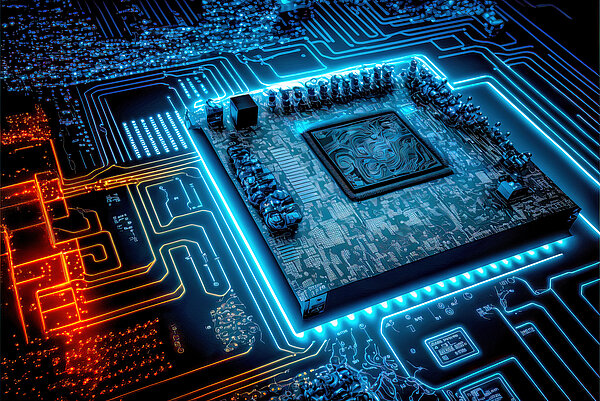MBSE & KI
MBSE (Model-Based Systems Engineering) is an approach to systems engineering in which models are used as central elements of information and communication throughout the entire development process. The use of artificial intelligence (AI) in combination with MBSE can help to automate complex systems analysis, support decision-making and increase efficiency. SysML v2 is a new version of the Systems Modelling Language (SysML) that offers improvements over the older SysML 1.x - including improved usability, extended functionalities and a greater focus on digital transformation.
The fusion of artificial intelligence (AI) with MBSE is a significant step in system development. This development opens up new ways in which AI algorithms can be integrated into the development process to increase efficiency, minimise errors and promote innovative solutions.

MBSE with SysML v2
SysML v2 is a new version of the Systems Modelling Language (SysML). The improvements compared to SysML v1 include:
- an extended language scope,
- a textual notation for models,
- greater internal consistency of the language,
- formally defined semantics,
- a standardised API (e.g. for modelling tools),
- improved automatic analysis.
HOOD can support the development and implementation of a company-specific modelling methodology. This includes:
- the identification of a useful subset of SysML (v2) for the company,
- the documentation of modelling guidelines,
- adapting and rolling out a modelling procedure that is integrated into the engineering process,
- evaluating the effectiveness of the MBSE process.
AI in Systems Engineering
The use of artificial intelligence (AI) in systems engineering offers numerous advantages. AI can enable the automation of complex systems analysis, which significantly improves the speed and accuracy of such analysis. In addition, AI supports decision-making by analysing large amounts of data and providing valuable insights that human experts might overlook. Furthermore, AI can increase efficiency by generating models and making suggestions for optimisation. This leads to a reduction in product development time and costs, as well as an improvement in system quality and reliability.

HOOD can help with a customer-specific integration of AI into the system development process. This includes:
- Analysis of company-specific processes and use cases for AI,
- Support in selecting the right type of AI solution (GenAI with Large Language Model, Knowledge Graphs etc.),
- Support in planning and implementing AI, e.g. AI assistants that are integrated into SysML modelling tools.

Ensuring consistency in development process
In system development, ensuring consistency refers to ensuring that all parts of the system - models, requirements, design specifications and implementations - are in agreement and coherent. This is important to avoid errors and ensure the quality of the end product.
With its consultancy services and operational support, HOOD can create and improve an appropriate set of MBSE models to check and ensure consistency. By coaching teams and key personnel, HOOD also ensures that the necessary working and collaboration models promote consistent and sustainable system development.
Automatic checks on system designs and AI assistants
Automatic checks on system designs include the use of software tools to check design models for errors, inconsistencies or non-compliance with requirements. These tools can help to identify and rectify problems early on in the development process.
AI assistants in systems engineering use automation techniques and AI-based tools to automate repetitive tasks, increase efficiency, support design decisions and improve the accuracy of analyses.


Transformations – SysML to SysML v2 and Text to SysML v2
Transformation in this context refers to the process of converting models from one language or version to another. For example, from SysML 1.x to SysML v2 or from textual requirements to SysML v2 models. These transformations can be automated to facilitate the migration of existing system models and increase efficiency in the creation of models by converting textual data directly into model-based formats.
In a nutshell, these concepts refer to advanced methods and technologies in the field of model-based systems engineering that aim to make the development of complex systems more efficient, consistent and effective.
HOOD Research in MBSE, AI and SE
We complement our strong expertise in standard systems engineering processes, methods and tools with a long-term commitment to research projects in order to develop solutions to new challenges for the future. Our research projects also create excellent visibility in one of our target industries (automotive). For our employees, we offer exciting research topics around AI and SE that support our competencies and employee retention.
HOOD can draw on 10 years of experience in AI automotive research
- AI approaches in vehicle development, in particular AI methods in the area of modelling and specification
- Natural Language Processing (NLP),
- Model-Text Transformation (SysML v2),
- Text-Model Transformation (SysML v2)
- Distributed, continuously learning board net management
- Model plausibility checks with AI and simulation
- BNE - support through AI
- Safety of self-driving vehicles
- Requirements management for security and safety requirements (Verification of ECU Specifications)
- Semi-automated, model-based development process for the development of functionally safe software
- Evaluation of technology and applications for vehicle components for use by multiple development partners and in different domains


SAFE4I Research Project
The project for safe software design for industrial plants
As one of thirteen partners, HOOD is involved in the BMBF-funded Safe4I project for functionally safe software in Industry 4.0.
When functional requirements and safety requirements are clearly separated, it enables us to build libraries of safety patterns. The aim of Safe4i is to describe these patterns based on models and to incorporate them (partially) automatically into functional code. In industrial practice, the focus on functional requirements significantly accelerates implementation while complying with important safety standards such as IEC 61511 and IEC EN 61508.
As a partner and work-package manager within the project, HOOD ensured that the requirements for safety software specifications are compiled, processes modelled and that meta-models are created. HOOD was also involved in the review process for those activities.
progressivKI Research Project
This project supports the development of efficient and safe electronic systems for future automotive applications with automated driving functions using a modular AI platform. We at HOOD have been involved in the ‘progressive AI’ project since April 2021. HOOD is one of eighteen partners in the consortium led by Robert Bosch Multimedia Car GmbH and Edacentrum.
Our common goal is to develop a generic design process with extensive AI support for electronic systems in vehicles. This is becoming increasingly important due to the growing system complexity in the development of autonomous and electrically powered vehicles. The tools used to date can no longer keep pace with the ever-increasing complexity. With AI, functionally safe electronic systems are to be developed faster, more reliably and more cost-effectively in the long term. This will increase both the performance and sustainability of these electronic systems. "In progressivKI, a modular AI platform is being developed. This AI platform can be used flexibly via secure, encrypted and intelligent connectors to the individual (distributed) AI modules," explains Dr Werner John from Edacentrum Hannover.


As a methodology leader in agile systems engineering, we support our customers in the implementation of complex development projects with suitable practices. In doing so, we realise that there are still no proven specification and verification practices available for safety-critical machine learning-based cyber-physical systems. There is still a need for research in this area. As part of the progressivKI project, we are evaluating and detailing our hypotheses and concepts for RE4KI, i.e. the further development of RE for AI systems.
We are also interested in how we can use algorithms and powerful AI systems to simplify the work of requirements and systems engineers. For us, the focus is always on people, which is why we ask ourselves what impact AI will have on those involved and on their collaboration.
Talk to us about your goals.
From analysis to implementation, we have the right experience, practices and methods for you and your engineering and product management throughout the entire product lifecycle.
